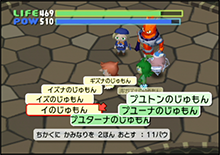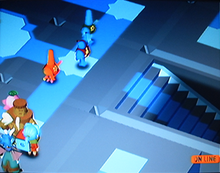Homeland (video game)
| Homeland | |
|---|---|
Single-player, multiplayer |
Homeland (
The game can be played offline in
Gameplay



Homeland features
The player begins by choosing and naming a boy or girl avatar. Next, there is an introductory sequence of events in which the player answers a few questions that will determine which two mascots the player will have from the start. A mascot is a sort of avatar that the player's avatar transforms into before setting off on an adventure.
Players begin each new adventure at level 1 and level up as they acquire experience points. A distinctive feature of Homeland is the ability of players to join hands and form a chain in order to combine their stats and special attributes. Players can be equipped with weapons, shields and accessories, and can carry a very limited number of items.
In an offline game, the player can summon their other mascots to come and assist them as though they were other players. These mascots become their companions and are controlled by the game's
Cooperative play
The online option does not become available until the first adventure has been completed offline.
Players in a multiplayer game do not normally battle each other; instead they benefit by helping each other to battle enemies and achieve common objectives. Some storylines cannot be completed without coordinated actions by a number of players. When players join hands to form a chain, the lead player in the chain is in control and is the only one able to attack or to receive damage.
The gamemaster begins a new game by selecting the "god" mascot and setting up the game parameters. During the game the gamemaster sees a map of the entire homeland and can "descend" to locations where there are players. The gamemaster can see a name list of all the players in the game, and can "jump" to the location of a selected player. Power points are needed to perform "miracles" (similar to skills) such as causing monsters or items to suddenly appear. In this way, the gamemaster is able to influence the game by helping or hindering the players. The gamemaster can suspend and save the game at any time and then resume from the saved state later; it is not necessary to keep the console switched on all the time. Game state is saved automatically every few minutes to the Memory Card in the game server console.
